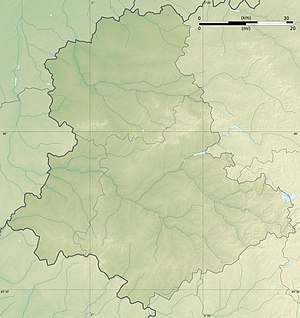Châlus-Chabrol Castle
| Châlus-Chabrol Castle | ||
|---|---|---|
|
The Châlus-Chabrol castle (2008) |
||
| Creation time : | 11th century | |
| Castle type : | Hilltop castle | |
| Conservation status: | ruin | |
| Place: | Châlus | |
| Geographical location | 45 ° 39 '27.5 " N , 0 ° 58' 47.5" E | |
|
|
||
The castle Châlus-Chabrol ( French Château de Châlus-Chabrol ) is the ruin of a medieval hilltop castle in France , which rises on the mountain Châlus above the village of the same name in the Haute-Vienne department in the Nouvelle-Aquitaine region . The castle is known for its siege by Richard the Lionheart in 1199, who was fatally wounded in the process.
Classified as a monument historique , the castle has been a listed building since March 1981 .
History and origin of name
The Châlus Castle was built in the 11th century by the Vice Counts of Limoges as a border fortification to the neighboring county of Périgord . The vice counts were traditionally anxious to maintain their autonomy vis-à-vis their liege lords , the dukes of Aquitaine , which often led to military conflicts. So did Vice Count Adémar V , who rebelled several times against Richard the Lionheart, the then Duke of Aquitaine. Lionheart finally besieged the vice-count's castle in 1199 and was badly wounded on March 25 by an arrow or crossbow bolt fired by the shooter Pierre Basile . He died of the wound a few days later.
A few years later, the French chronicler Rigord wrote in his Gesta Philippi Augusti that Richard the Lionheart had received the fatal wound during the siege of the castrum lucii de Capreolo . He also wrote that Lionheart only besieged this castle because a knight of the Vice Count of Limoges had previously discovered a large treasure of gold and had hidden it in that castle. Lionheart had nevertheless found out about the treasure and raised his own claims as to what led to the fatal siege for him. In addition to Rigord, the chroniclers Roger of Hoveden , Radulph von Coggeshall , Wilhelm the Breton and the Annals of Margam also mentioned an alleged gold treasure as a motive for Richard's attack on Châlus. Based on these reports, the legend of Lucius Capreolus, who is said to have officiated as proconsul of the Roman Empire in Aquitaine in the age of Caesar Augustus , developed from the 13th century . Because he was an outstanding mountain fighter, he was nicknamed "Capreolus" (translated from Latin: roebuck, also wild billy goat). The legend goes on to say that he finally built the castle on Mount Châlus, which is why it is now called Châlus-Chabrol. He and his descendants also invested a huge treasure in their combs, which belonged to the Vice Counts of Limoges as their rightful descendants, which Lionheart unlawfully denied and was therefore punished with death. The legend was first recorded in writing at the beginning of the 17th century.
In the middle of the 13th century, an heiress of the vice-count's family sold the Châlus castle to the clergyman Géraud de Maulmont , who built the Châlus-Maulmont castle nearby. King Philip IV the Handsome expropriated the Maulmont heirs, and Châlus was sold to the House of Albret in the early 14th century . Alain d'Albret gave Châlus as a dowry to his daughter Charlotte in her marriage to the Renaissance prince Cesare Borgia . Both daughter Louise Borgia († 1553) brought Châlus into the marriage with Philippe de Bourbon-Busset, whose descendants until 1995 bore the title "comte de Bourbon-Châlus" (German: Count of Bourbon-Châlus).
literature
- John Gillingham : The unromantic Death of Richard I. In: Speculum 54 (1979), pp. 18-41.
Web links
Individual evidence
- ^ Castle Châlus-Chabrol in the Base Mérimée of the French Ministry of Culture (French), accessed on August 10, 2011.
- ^ Rigord: Gesta Philippi Augusti. In: Henri-François Delaborde (ed.): Œuvres de Rigord et de Guillaume le Breton . Volume 1. 1882/95, pp. 144-145.
- ↑ Emile Ruben, Félix Archard, Paul Ducourtieux (eds.): Annales manuscrites de Limoges dites manuscrit de 1628. Limoges 1872. Cf. John Gillingham: The unromantic Death of Richard I. In: Speculum 54 (1979), p. 18– 41, here: p. 40.

